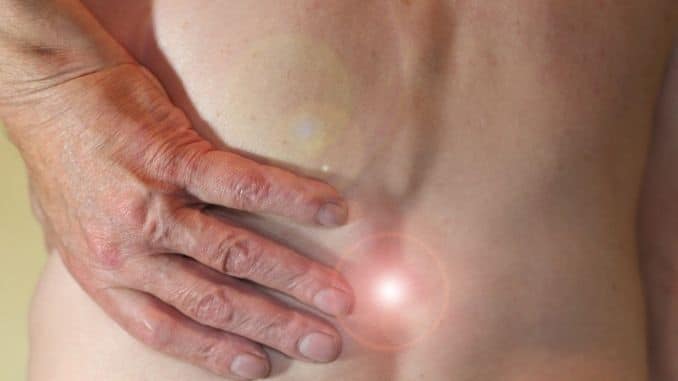
If you’re suffering from lower back pain, it can be difficult sometimes to figure out what is causing it. It could be muscle tightness, a disc problem, spondylolisthesis or sacroiliac joint (Si joint) pain.
According to a 2014 study, SI joint pain could be a factor in up to 15 percent of all cases of chronic lower back pain, which means it could affect about 10 million people in the United States.
Below, we give you some tests you can try to help determine if your pain is coming from inflamed SI joints and provide stretches and exercises known to help relieve SI joint pain.
What Is the SI Joint?
The SI joint connects the sacrum and the ilium bones of the pelvis. The sacrum is the lowest part of the spine right above the tailbone. The iliac bones are the “wings” on the pelvis — the uppermost and largest parts of the pelvis.
If you picture the pelvis like a bowl or a girdle, the ilium bones are the two sides that extend upward and are curved to form the bowl-like shape.
The SI joint sits in between these large bones and the sacrum. When you look at a picture of the pelvis, they appear almost like cracks or slim connections between the pelvis and the sacrum. When looking at a person from the back, the SI joints can be located below the waist where the two dimples are visible. Strong ligaments and muscles encase and cover the joints to compress and stabilize them.
Normal Function of SI Joints
In our day-to-day lives, the SI joints provide support and stability to the pelvis and play a major role in absorbing impact when we’re walking or lifting. Normally, the joints don’t move very much — only about 2 to 4 millimeters in any direction. In women, the ligaments around these joints are more flexible than they are in men to allow for childbirth.
Just like any joint, the SI joint contains cartilage and synovial fluid to over the surfaces and allow for smooth movement. In time, this cartilage can wear thin, and the ligaments can stiffen, stretch and degenerate, allowing the joint to have excessive motion. That motion can inflame and disrupt the joint and surrounding nerves. SI joint pain is typically called “sacroiliitis,” meaning inflammation of the SI joint.
Common Causes of SI Joint Dysfunction and Pain
The SI joint can be injured by various activities, including:
- Falls on the backside
- Carrying a heavy object and twisting
- Traumatic injury
- Leg length discrepancy
- Gait abnormalities
- Prolonged, vigorous exercise
- Traumatic birth; pregnancy, which may lead to abnormal wear and tear
- Sacroiliac joint arthritis, which is usually from conditions like autoimmune disorders, ankylosing spondylitis, rheumatoid arthritis, Reiter’s syndrome or psoriatic arthritis
If the ligaments around the SI joints become too loose or too tight, pain may also occur. This may be caused by a fall, work injury, hip or spine surgery or pregnancy and childbirth.
Uneven movement in the pelvis can also lead to SI joint pain. This can occur when one leg is longer or weaker than the other or with arthritis in the hip and/or knee. Even non-supportive footwear can lead to SI joint pain.
How Can You Tell If the Pain Is Coming From the SI Joint?
SI joint pain can be difficult to pinpoint because the symptoms often mimic other conditions like a herniated disc, sciatica, or hip problems. It’s always best to check with your doctor for a diagnosis.
Common symptoms of SI joint inflammation or dysfunction include:
- Lower back pain
- Pain in the buttocks
- Pain that radiates to the lower hip, groin or upper thigh
- Numbness or tingling in the leg or a feeling of weakness in the leg
- Feeling of instability in the leg like buckling or giving way
- Pain that gets worse with prolonged standing, bearing weight more on one leg than the other, stair climbing and running
- Pain that feels worse when sitting or sleeping on the affected side
- Pain that gets worse when driving in a car, or sitting or walking too long
- Pain when going from a seated to a standing position
There are also specific tests that doctors use to determine if the SI joint is the source of a person’s pain. Doctors typically manipulate the joint and feel for tenderness in the SI area. Imaging tests like X-rays and CT scans may also be used to examine the bones and joints in and around the pelvis and hips.
Another reason why SI joint problems can be difficult to identify is that they often co-exist with other issues, such as hip joint pain or lower back pain, which may come from other causes. Your doctor can help you determine exactly what may be going on. Meanwhile, here are some tests you can perform yourself to determine if your SI joints may be inflamed.
1. Figure 4 Test (Faber Test)
Lie flat on your back. Bend your right leg and cross your foot over your left knee. This should create a “4” shape with your body. Then, push your bent knee gently down toward the floor, or have a partner gently push down on your bent knee. If you feel that familiar pain that you’ve been feeling — if this movement reproduces the pain — it “may” be caused by inflamed SI joints.
2. Edge-of-Bed Test (Gaenslen’s Test)
Lie down on your back at the edge of your bed or table. Be careful not to fall off. Lower the outside leg off the side of the bed so that it’s hanging and, at the same time, bend your other knee straight up toward your chest.
Have a partner push on your bent knee so that it comes nearer your chest while simultaneously pushing down on your straight leg that is suspended off the edge of the bed. Your partner can also push the bent knee outward slightly. If this movement reproduces your pain, the SI joints may be to blame.
3. Compression Test
Lie on the floor on your side, knees slightly bent and together, with the painful side up. Have a partner push down on your pelvis — right over your hipbone. Your partner should place one hand on top of the other right over the hipbone and press down. If you feel pain in the SI joint area, which is lower in the buttock than where your partner is pushing, it could be SI joint pain.
4. Sacrum Pressure Test
Lie on your stomach on the floor or a firm surface. Have a partner press down on the sacrum, which is just slightly under the belt area in the center where that bone is. Again, if you feel pain with the pressure, it could be SI joint pain.
If you experienced pain with one or more of these tests, you may have SI joint inflammation.
Treatments for SI Joint Pain
If your doctor diagnosis your pain as being caused by the SI joint, treatments may include the following:
- Nonsurgical: These may include physical therapy, chiropractic manipulation and stretching exercises. Many patients improve with these treatments. To manage pain, anti-inflammatory medications, creams, salves and braces or bands can all help.
- Injections: Steroidal injections into the joints can help reduce swelling and inflammation. These involve an injection of a corticosteroid and an analgesic-numbing agent into the affected joints. The results are temporary, but injections can be repeated up to three times a year.
- Nerve ablations: These are injections into the nerves rather than into the joint. They can block the nerve so that it no longer sends painful messages to the brain. The procedure uses an electrical current to destroy the nerve fibers that carry pain signals.
- Surgery: Used only as a last resort, surgery typically involves placing metal implants and bone graft material to stabilize the joint.
7 At-home Stretches and Exercises for SI Joint Pain
There are steps we can take to prevent SI pain:
- Practice good posture when sitting, standing and moving
- Use proper lifting techniques
- Create an ergonomic work area
- Engage in regular exercise and stretching and strengthening
Once you’re struggling with SI pain, the following stretches and exercises may help. As always, if you feel pain, stop the exercise and see your doctor.
1. Knee-to-Chest Stretch
Lie on your back on the floor with your legs extended straight out. Draw one knee into your chest as far as you can while keeping the other leg straight down. You should feel a stretch in your buttocks. Hold for 5 to 10 seconds, then lower back down. Repeat with the other leg. Complete eight to 10 repetitions for each leg.
Another similar stretch involves pulling both knees into your chest and hugging them, allowing your spine to relax into the floor. Hold for 5 to 10 seconds and lower your legs slowly. Repeat eight to 10 times.
2. Knee Rotation
Lie flat on your back with your knees bent and both feet flat on the floor. Keeping your spine and feet anchored to the floor, allow your knees to sway gently to the left, hold for a few seconds, then return to center. Repeat on the right side for eight to 10 repetitions on each side.
3. Cobra
Lie flat on your stomach. Slide your hands beneath your shoulders and push up gently, bringing your upper body off the floor while keeping your pelvis and legs on the ground. Pull your shoulders down and away from your ears as you push up. Try to relax your lower back and buttocks. Hold for 15 to 30 seconds and lower down slowly. Repeat three times.
4. Child’s Pose
Start on your hands and knees. Push back slowly to rest your buttocks on your heels while you extend your arms out in front of you, with your palms facing down. Hold for 30 to 60 seconds, and then come back up. Repeat three times.
5. Reset SI Move
Lie on your back with your knees bent and feet flat on the floor. Place a softball or rolled-up towel between your knees. Squeeze your knees together gently while keeping your feet on the floor. Hold for a count of five and release. Repeat three to five times.
6. Belt Press
You need a regular belt for this exercise — not a resistance band. Sit down on the floor and tie the belt around your legs above your knees, so you’re essentially tying your legs together, but allow a little give between them. Then, lie down and with your knees bent and feet flat on the floor and press your knees outward against the belt. You should feel the resistance. Press out for 10 to 15 seconds, relax, and then press again. Repeat eight to 10 times.
7. Seated Hamstring Stretch
While sitting on a firm chair, straighten one leg while still keeping the foot on the floor. Straighten so your knee is no longer bent. Then, lean forward over that leg, bending from the waist, until you feel a stretch in the back of the leg. Hold for 10 to 15 seconds, then repeat on the other side. Repeat eight to 10 times.
In addition to doing the above exercises, it’s best to avoid the following activities as they are likely to exacerbate SI joint pain:
- Crunches or sit-ups
- Heavy lifting, particularly moves that involve the lower back
- Contact sports that could injure the SI joint
- Any exercise that involves a lot of twisting or turning at the hips
- Excessive biking or long bike rides
For help eliminating your SI joint pain, check out our Sacroiliac Pain Solution, here!
.





